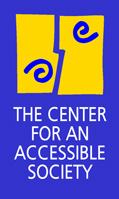
DISABILITY
ISSUES
INFORMATION
FOR
JOURNALISTS
ABOUT
THE CENTER
'Liquid web design' resources extend access, usability
Note to readers: links to news articles may not work after a few weeks, as news media remove current stories to their archives. The link may take you to the archives section, where, for a fee, you can view the article.
April 8, 2003 -- In last week's E-letter, we looked at how universal design resources are beginning to change the housing market -- particularly with a concept known as "visitability." But universal design -- design not specifically "for the disabled" but design that works for the largest group of users, has also affected web design. "Liquid web design" is the term for web design that works with the largest number of "interfaces." It also happens to ensure that the design is accessible to people with disabilities.
"The web is not print," liquid web design adherents explain. But "people who find themselves faced with the task of creating or commissioning a Website tend to think in terms of print. It's what we know, after all," says web designer Nick Wilson. "But, in fact, the Internet can be accessed with many different variations of browser, platform, settings or even devices." Different browsers display web pages differently. A page displayed on Netscape looks different than one displayed on Internet Explorer. People can, and do, change their own browser settings and screen resolutions. They make fonts bigger, or smaller. Type fonts are different on different computers. Some people with slower dial-up connections simply turn off the graphics option completely, as graphics are much slower to "load" and can waste time for people who don't have high-speed connections. People turn off Javascript options, or don't have it on their older computer. And people are still using the very old Mozilla and Opera browsers. Read Wilson's article at http://www.sitepoint.com/print/951
None of this is directly related to disability. It's simply acknowledgement of the fact that people in general use various ways of accessing the web. People with vision disabilities use text-based browsers and screen readers. But WebTV subscribers, and people with hand-held PDAs run into the same problems. Liquid web design as a concept developed parallel to "accessible" web design -- it's based on the same concepts, but it doesn't focus specifically on users with disabilities but all users, in general.
"Build it right and it will work, no matter what the "container'" says designer Nick Finck in Digital web online magazine. Read Finck's tutorial on liquid web design at http://www.digital-web.com/tutorials/tutorial_1999-10.shtml Another good article can be found at http://www.evolt.org/article/Liquid_Design_for_the_Web/20/15177/ Web designer Carmen Mardiros has links to a number of articles about liquid web design on her website.
Earlier E-Letters on web accessibility include "Federal website usability not yet up to speed," with links to more articles.